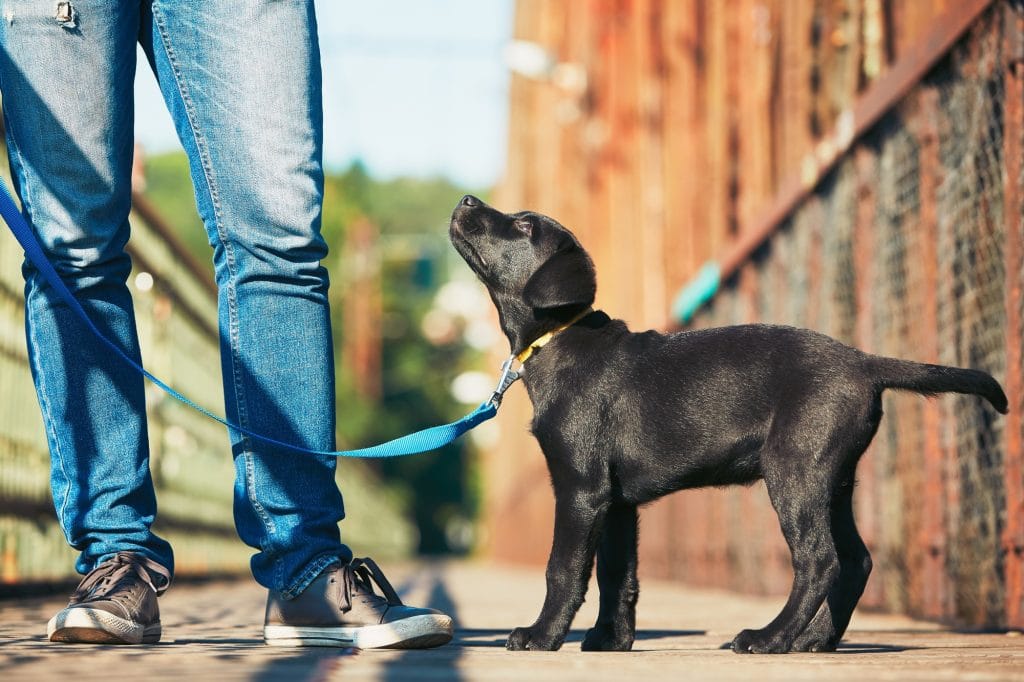The day you went to the animal shelter to pick out your new best friend, you began dreaming up visions straight from the movies.
“Me and my buddy, hiking in the Himalayas!”
“Me and my buddy, placing first in the agility course!”
“Me and my buddy, rescuing Timmy from the well!”
Twenty-four hours later, your buddy is gnawing on their leash while rolling on the grass in the middle of the street and needs you to dissuade them from eating trash. Before you and your furry friend can take on the world, you’ll need to begin puppy training—but is it too soon to start?
We’ve created this guide to help new dog owners understand the timeline for training a puppy, including when to start and how to proceed. We’ll offer you a few tried and true tips for introducing age-appropriate behaviors that will pay dividends down the line.
Read on to learn how to go from puppy to prodigy without breaking a sweat.
When Is the Right Time to Train a Puppy?
If your puppy is home with you, they’re probably at least eight weeks old. This is when a dog is old enough to survive and thrive away from its mother. This independence also makes it the perfect time to begin training a dog in earnest.
In the beginning, training sessions will be short and sweet. Like human babies, puppies have short attention spans. Five minutes of “work” is about as much as a new puppy can handle before they’re ready for another nap.
We recommend scheduling your five rigorous minutes of dog training right before your puppy’s mealtime. Puppies are growing animals, and food is an intrinsic reward for their focus and effort. Plus, you’ll build a positive association between your dog’s bowl and your presence.
Begin With the “Wait” Command
Keep your early lessons simple. Puppy training involves positive reinforcement and negative punishment.
Positive reinforcement is when you immediately reward the behavior you want to see. It must be immediate if you want your puppy to associate the behavior with the reward.
Negative punishment is when you remove the reward following an undesirable behavior. Like positive reinforcement, it must be immediate and tied directly to their behavior.
When your dog is sitting by their bowl, give them the “wait” command in a clear voice. If they stay seated, you can reward your puppy with a single piece of food as positive reinforcement.
The next step is to issue the “wait” command and then remove the bowl. If they stay seated, give them another piece of food. If they move, put the bowl aside and out of view. Repeat this process until they learn to sit still after hearing the “wait” command, whether their bowl is present or not.
Practice this behavior every time you feed your dog. See if they can maintain the “wait” command with the bowl halfway to the floor. This is an excellent way to encourage good manners while addressing routine puppy care.
Consider Crate Training
Some puppy owners may also want to try crate training. This can give you and your dog space and help curb anxiety. Successful crate training can often take weeks or months, so beginning early is wise.
The first step is to acquire a crate, such as a dog front carrier, which is the right size for your puppy. Make sure to choose a create based on their estimated adult size. This can be tricky if you’re training a mutt, so ask your vet for their best guess.
When your dog is calm, bring them to the crate. Use positive reinforcement to reward them for going inside. Some pet owners use a frozen treat the puppy has to work for to encourage them to remain in the crate longer.
Increase the time your dog spends in the crate incrementally. Puppies don’t need to spend more than ten minutes at a time in their crates. Increase the time your dog spends in the crate by about five minutes.
The first time you crate your dog while you’re out of the house, you might want to use a camera to see how they behave while you’re gone. This can provide good insight into their state of mind. Ideally, your dog will be calm and relaxed in their crate.
Other Commands For Puppies
Crate training and the “wait” command help form a strong training foundation. If your puppy responds, you can begin to introduce other foundational commands. Most puppies are eager to please and love rewards, so it isn’t too early to start if they’re interested.
Here are a few commands you can introduce in the first few months with your pup:
- Come
- Sit
- Lie down
- Stay
- Watch me
- Down
- Drop it
You might also want to begin loose-leash walking with your puppy. This is similar to the “heel” command. The goal is to encourage your dog to stay at your side, which can be a matter of safety once walks move beyond the backyard.
Before you can train your dog to walk, you’ll need to train them to wear their leash without a struggle. Use those positive reinforcements every time you put the leash on your dog. From there, the real training can begin!
Puppy Training Takes Time
You chose your puppy because you believed in its potential. That potential isn’t going anywhere now that they’re in your home, chewing on your favorite shoes. The key to puppy training is radical patience as your little friend transforms from a puppy into a strong, intelligent, capable dog.
While you wait for your dog to catch on, you might have some extra time to kill. Check out the rest of the blog for more posts that can teach you how to take on the world.







